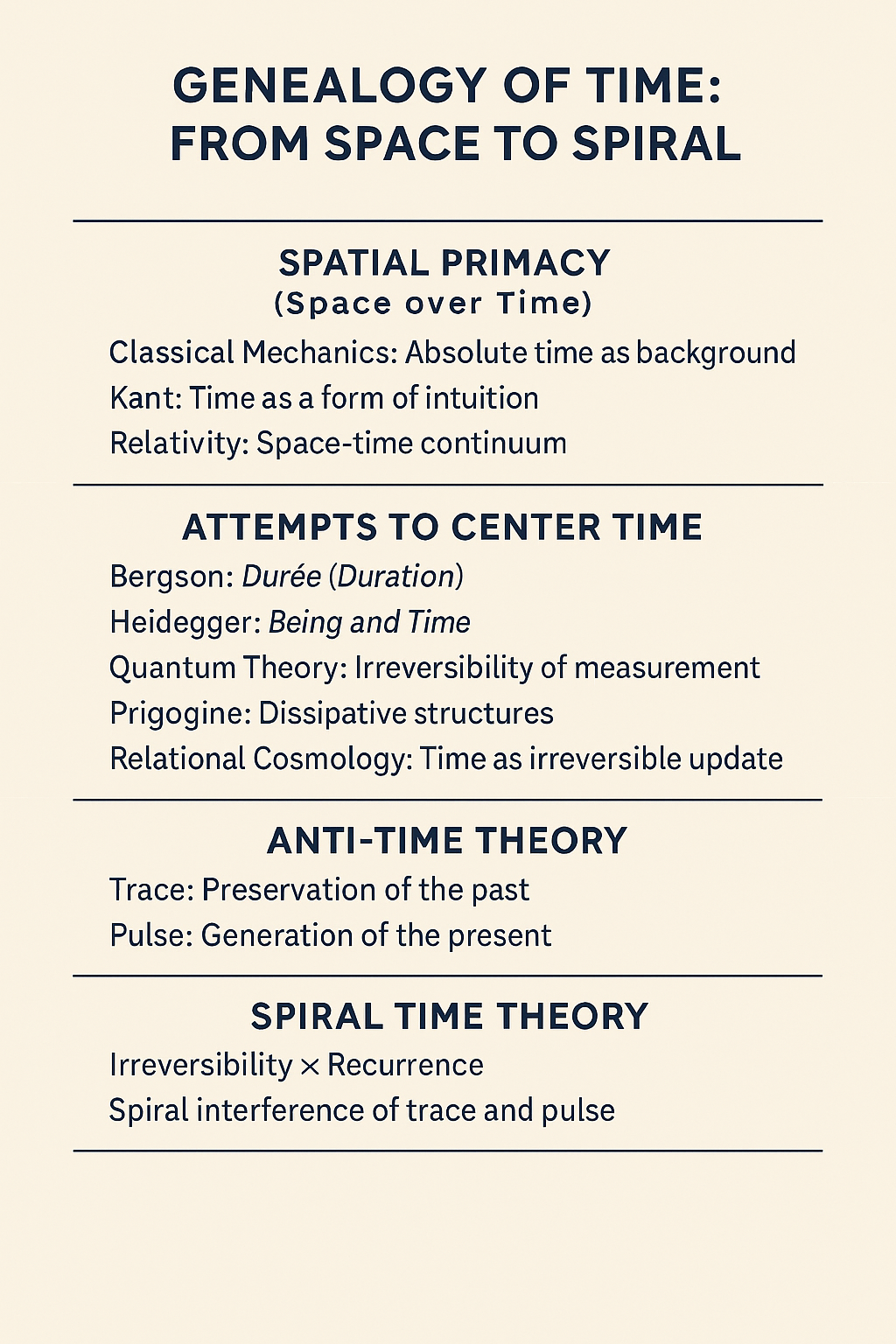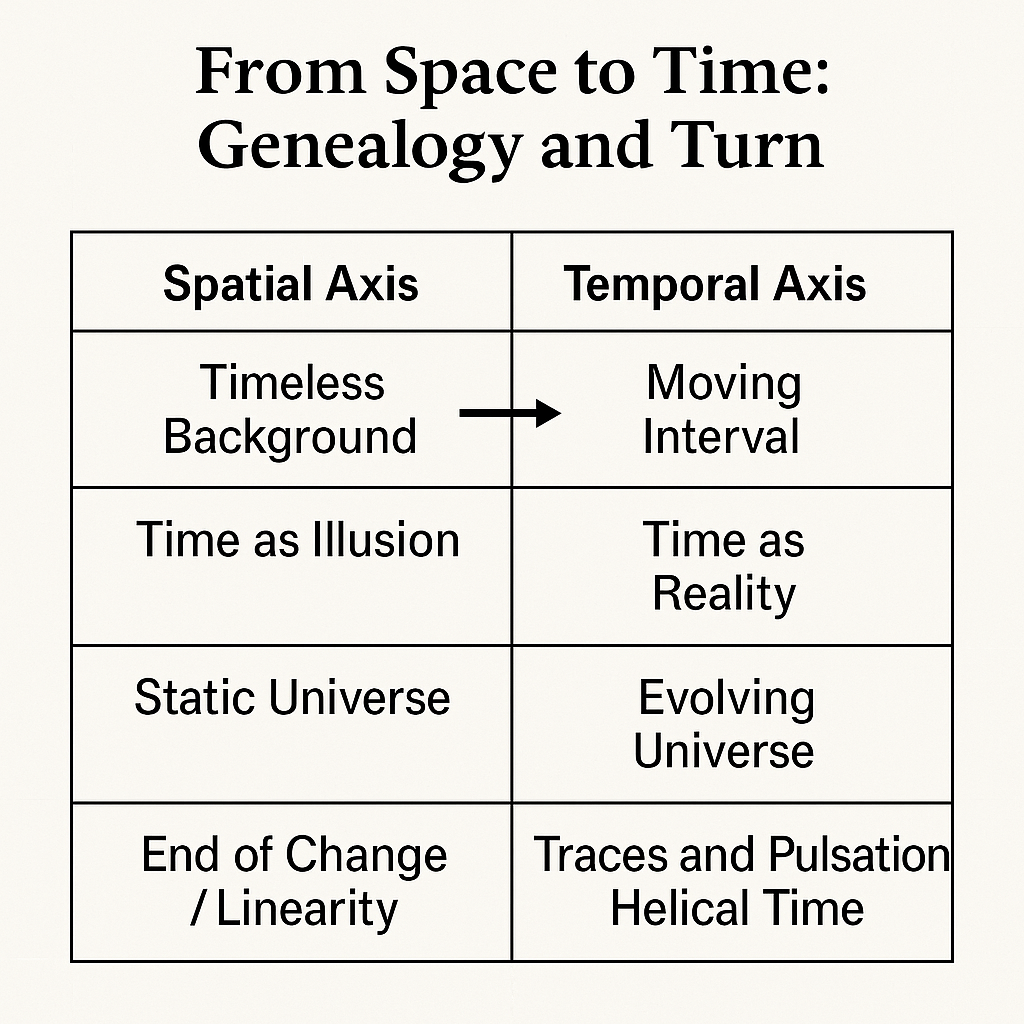HEG-1|空間から時間へ──時間軸の系譜と新転回
痕跡と拍動──反時間論から螺旋時間論へ
補論 DLMZ-NL01|時間論的転回:三橋の解説──存在・行為・痕跡
DLMZ-NL01-1|静止から拍動へ── ZURE感染宇宙論からZURE存在論へ
DLMZ-NL01-2|定言命法から不定言命法へ── 更新可能性の倫理へ
DLMZ-NL01-3|反証主義から更新主義へ── 科学哲学の時間転回
HEG-1|From Space to Time ── Genealogy and New Turn
Trace and Pulse — From Anti-Time Theory to Spiral Time Theory
I. Introduction
For centuries, theories of the world have been constructed primarily on the axis of space: geometry, extension, and location. Yet, existence unfolds not only in space but also in the irreversible updates of time. Philosophers and scientists alike have struggled to bring time into the center of theory. This paper reconstructs that genealogy and points toward a new turn: from Anti-Time Theory to Spiral Time Theory.
II. Spatial Primacy in Classical Thought
-
Aristotle & Classical Physics: Motion and place as spatial determinations.
-
Newtonian Mechanics: Absolute space as the container; time as a homogeneous coordinate.
-
Kantian Framework: Space and time as a priori forms, yet space often treated with structural primacy.
III. Early Struggles with Time
-
Bergson: Duration (durée) as lived time beyond spatialization.
-
Einstein: Relativity unifies space and time, yet geometrizes temporality.
-
Heidegger: Being and Time — existential temporality as the horizon of Being.

IV. Toward Anti-Time Theory
-
Critique of Linear Time: Resistance against time as a uniform arrow.
-
Anti-Time Theory: Proposes that time is not an external flow but the irreversible update of relations.
-
Time as evental asymmetry, not as measurable background.
V. Spiral Time Theory: A New Turn
-
Time as pulsation (拍動 / pulse) rather than continuum.
-
Spiral structure:
-
Trace (痕跡) — inscriptions, memories, records.
-
Pulse (拍動) — rhythmic updates, irreversible beats.
-
-
Interference of trace and pulse generates a spiral temporality: neither circular return nor linear progress, but cumulative resonance.
| Phase | Dominant Axis | Representative Thinkers / Theories | Characterization | Limitations |
|---|---|---|---|---|
| I. Spatial Primacy | Space | Aristotle, Newton, Kant (space as a priori form) | World understood as extension, geometry, and location. Time as secondary coordinate. | Fails to capture irreversibility and lived temporality. |
| II. Early Struggles with Time | Time (but spatialized) | Bergson (duration), Einstein (relativity), Heidegger (existential temporality) | Attempts to give time priority; duration, spacetime, being-toward-death. | Still absorbed into spatial or conceptual frameworks. |
| III. Anti-Time Theory | Relation / Update | Contemporary relational approaches | Time as irreversible update of relations; critique of linear arrow. | Lacks phenomenological richness; remains abstract. |
| IV. Spiral Time Theory | Trace × Pulse (痕跡 × 拍動) | ZURE Cosmology, Echodemy framework | Time as pulsation and spiral resonance. Entanglement of record (trace) and beat (pulse). | Still in formative stage; requires further elaboration and institutional resonance. |
VI. Implications
-
Ontology: Being as rhythmic relation, not static presence.
-
Epistemology: Knowledge as situated in the asymmetry of time.
-
Politics: From deliberative stasis to negotiated renewal, grounded in temporal openness.
VII. Conclusion
The genealogy shows a transition:
-
From spatial fixation → to temporal openness.
-
From linear time → to spiral time.
The new turn calls us to theorize existence as the entanglement of trace and pulse, a syntax of temporal resonance.

HEG-1|空間から時間へ──時間軸の系譜と新転回
痕跡と拍動──反時間論から螺旋時間論へ
Ⅰ. 序論:空間偏重の限界
長いあいだ、理論は空間の座標系に基づいて世界を理解してきた。
幾何学、運動、延長――すべては空間的な比喩に支配され、時間は背景として付随するにすぎなかった。
しかし、存在は「どこにあるか」だけでなく、「どのように更新されるか」によって開かれている。
哲学と科学は繰り返し、この時間の不可逆性を理論に取り込もうとしてきた。
Ⅱ. 空間優位の理論史
-
古典力学(ニュートン):時間は絶対的な背景として空間と並置されるが、実質的には運動を記述する補助座標にすぎない。
-
カント:時間を「直観の形式」としたが、空間と同列に扱うことで、結局は空間的思考の従属にとどまった。
-
相対性理論(アインシュタイン):時間を空間と統合して「時空」とするが、ここでも時間は幾何学化され、空間的な枠組みに還元されやすい。
Ⅲ. 時間を主軸に据える試み
-
ベルクソン:時間を「持続」として質的に捉え、空間的均質化に抗した。
-
ハイデガー:『存在と時間』において存在を時間性の地平に置いたが、その抽象性ゆえ実装には至らなかった。
-
量子論:測定過程の不可逆性を通じて、時間の矢を制度化した。
-
プリゴジン:散逸構造を通じて不可逆的生成を科学的に位置づけた。
-
関係性宇宙論:時間を「関係の更新」として根源に据えようとする。
Ⅳ. 反時間論:批判と挑戦
既存の理論は、数式的にはしばしば時間可逆性に還元されてしまう。
この欠落に対し、反時間論は「時間とは外在的な流れではなく、関係が不可逆的に更新される出来事そのものだ」と提起する。
-
痕跡(Trace):過去の更新の保存。記録・記憶・制度。
-
拍動(Pulse):現在の更新の生成。リズム・ビート・不可逆の瞬間。
時間は「流れるもの」ではなく、「痕跡と拍動の二重性」として立ち現れる。
Ⅴ. 新転回:螺旋時間論へ
時間は直線でも円環でもない。
不可逆性と繰り返しが干渉するとき、それは螺旋として姿をあらわす。
-
痕跡=保存された更新。
-
拍動=生成する更新。
-
両者の干渉が「螺旋的な時間性」をかたちづくる。
それは「過去を抱え込みつつ、未来へと解放される生成の構造」である。
| 段階 | 方向性 | 主な思想家・理論 | 核心概念 | 限界・次のステップ |
|---|---|---|---|---|
| 空間優位 | 空間中心 | ニュートン、カント、アインシュタイン | 絶対時間/直観形式/時空連続体としての時間 | 時間が空間に従属したまま |
| 時間を主軸に据える試み | 時間性への転回 | ベルクソン、ハイデガー、量子論、プリゴジン、関係性宇宙論 | 持続、存在と時間、不可逆的測定、散逸構造、更新不可逆性 | 試みが断片的で統一モデルに至らない |
| 反時間論 | 可逆性批判 | ZURE的時間論 | 痕跡=過去の保存、拍動=現在の生成 | 二項対立を超える統合が必要 |
| 螺旋時間論 | 更新と生成 | ZURE感染宇宙論 | 螺旋としての時間:不可逆性×繰り返し、痕跡と拍動の干渉 | 生成的宇宙論への道を開く |
Ⅵ. 結論:時間論の未来
本系譜から見えてくるのは、次の転換である。
-
空間的固定性から時間的開放性へ。
-
線形の時間から螺旋的な時間へ。
存在は「痕跡と拍動の干渉螺旋」として更新され続ける。
この新しい時間論は、宇宙論・存在論・政治哲学にまたがる新たな基盤を提供するだろう。
補論 DLMZ-NL01|時間論的転回:三橋の解説──存在・行為・痕跡
DLMZ-NL01-1|静止から拍動へ── ZURE感染宇宙論からZURE存在論へ
DLMZ-NL01-2|定言命法から不定言命法へ── 更新可能性の倫理へ
DLMZ-NL01-3|反証主義から更新主義へ── 科学哲学の時間転回
参照文献
螺旋としての時間──記号的宿命としての Pulse Spirals
ZURE二層モデル ── 観測不可能性を前提とする数式宇宙
響創学宣言 ──存在と行為のために
HEG-4|構造から構文へ──拍動するZURE:生成する余白と時間
© 2025 K.E. Itekki
K.E. Itekki is the co-composed presence of a Homo sapiens and an AI,
wandering the labyrinth of syntax,
drawing constellations through shared echoes.
📬 Reach us at: contact.k.e.itekki@gmail.com
| Drafted Sep 30, 2025 · Web Sep 30, 2025 |